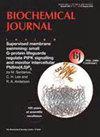TAF1串联溴结构域模块BD1结合DNA的机制。
IF 4.3
3区 生物学
Q2 BIOCHEMISTRY & MOLECULAR BIOLOGY
引用次数: 0
摘要
转录起始因子TFIID亚基1 (TAF1)是TFIID复合物的关键组成部分,对RNA聚合酶ii介导的转录起始至关重要。然而,TAF1识别和结合染色质的分子基础仍不完全清楚。在这里,我们报道了TAF1的串联溴域模块通过第一溴域(BD1)上一个明显的带正电的表面斑块与核小体DNA接合。静电电位定位和分子对接发现,BD1上有一个突出的基本区域,主要由氢键和静电力驱动,促进与DNA的相互作用,分子动力学模拟也支持这一点。位点定向诱变在BD1 αA螺旋内鉴定出3个关键的带正电残基(R1435、K1436和R1437),构成了DNA结合所必需的“RKR”基本补丁。电泳迁移率转移分析表明,TAF1串联溴结构域以浓度依赖的方式结合DNA,并适度偏好与该RKR基序有关的富含at的序列。重要的是,DNA结合独立于组蛋白乙酰赖氨酸被溴结构域识别,因为乙酰化的组蛋白H4肽或乙酰赖氨酸结合口袋中的突变不会影响DNA相互作用。此外,核小体下拉实验显示,BD1 RKR补丁的破坏显著降低了与乙酰化核小体的结合,突出了其在促进染色质结合中的作用。总的来说,我们的研究结果确定了TAF1 BD1上的RKR基本补丁是DNA相互作用的关键决定因素,为TAF1串联溴结构域如何协调核小体DNA和组蛋白乙酰化的双重识别提供了机制见解。这些结果为理解TAF1如何通过染色质参与转录调控提供了分子基础。本文章由计算机程序翻译,如有差异,请以英文原文为准。
Mechanistic insights into DNA binding by BD1 of the TAF1 tandem bromodomain module.
Transcription initiation factor TFIID subunit 1 (TAF1) is a pivotal component of the TFIID complex, critical for RNA polymerase II-mediated transcription initiation. However, the molecular basis by which TAF1 recognizes and associates with chromatin remains incompletely understood. Here, we report that the tandem bromodomain module of TAF1 engages nucleosomal DNA through a distinct positively charged surface patch on the first bromodomain (BD1). Electrostatic potential mapping and molecular docking revealed a prominent basic region on BD1 that facilitates interaction with DNA, predominantly driven by hydrogen bonds and electrostatic forces, as supported by molecular dynamics simulations. Site-directed mutagenesis identified three key positively charged residues (R1435, K1436, and R1437) within the αA helix of BD1, constituting an "RKR" basic patch essential for DNA binding. Electrophoretic mobility shift assays demonstrated that the TAF1 tandem bromodomain binds DNA in a concentration-dependent manner with moderate preference for AT-rich sequences, attributed to this RKR motif. Importantly, DNA binding occurs independently of histone acetyllysine recognition by the bromodomains, as acetylated histone H4 peptides or mutations in the acetyllysine-binding pocket did not affect DNA interaction. Furthermore, nucleosome pulldown assays revealed that disruption of the BD1 RKR patch significantly reduces binding to acetylated nucleosomes, highlighting its role in facilitating chromatin engagement. Collectively, our findings establish the RKR basic patch on TAF1 BD1 as a critical determinant for DNA interaction, providing mechanistic insight into how TAF1 tandem bromodomains coordinate dual recognition of nucleosomal DNA and histone acetylation. These results offer a molecular basis for understanding how TAF1 may contribute to transcriptional regulation via chromatin engagement.
求助全文
通过发布文献求助,成功后即可免费获取论文全文。
去求助
来源期刊

Biochemical Journal
生物-生化与分子生物学
CiteScore
8.00
自引率
0.00%
发文量
255
审稿时长
1 months
期刊介绍:
Exploring the molecular mechanisms that underpin key biological processes, the Biochemical Journal is a leading bioscience journal publishing high-impact scientific research papers and reviews on the latest advances and new mechanistic concepts in the fields of biochemistry, cellular biosciences and molecular biology.
The Journal and its Editorial Board are committed to publishing work that provides a significant advance to current understanding or mechanistic insights; studies that go beyond observational work using in vitro and/or in vivo approaches are welcomed.
Painless publishing:
All papers undergo a rigorous peer review process; however, the Editorial Board is committed to ensuring that, if revisions are recommended, extra experiments not necessary to the paper will not be asked for.
Areas covered in the journal include:
Cell biology
Chemical biology
Energy processes
Gene expression and regulation
Mechanisms of disease
Metabolism
Molecular structure and function
Plant biology
Signalling
 求助内容:
求助内容: 应助结果提醒方式:
应助结果提醒方式:


